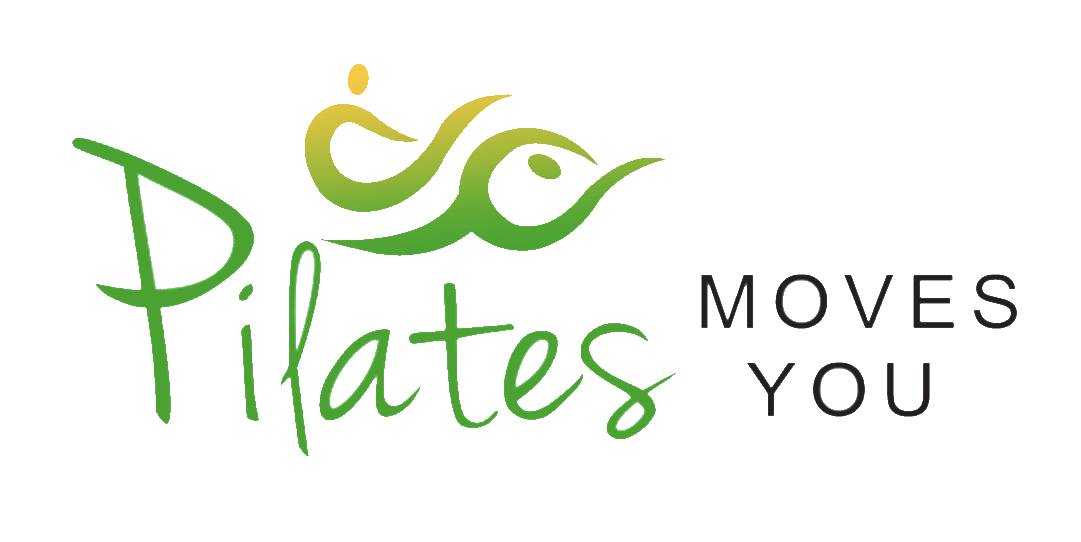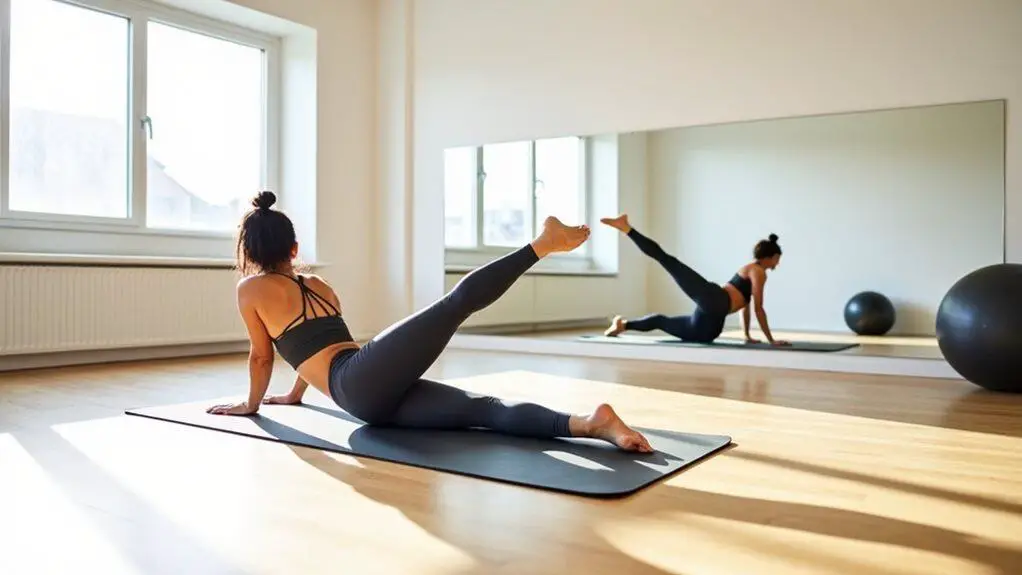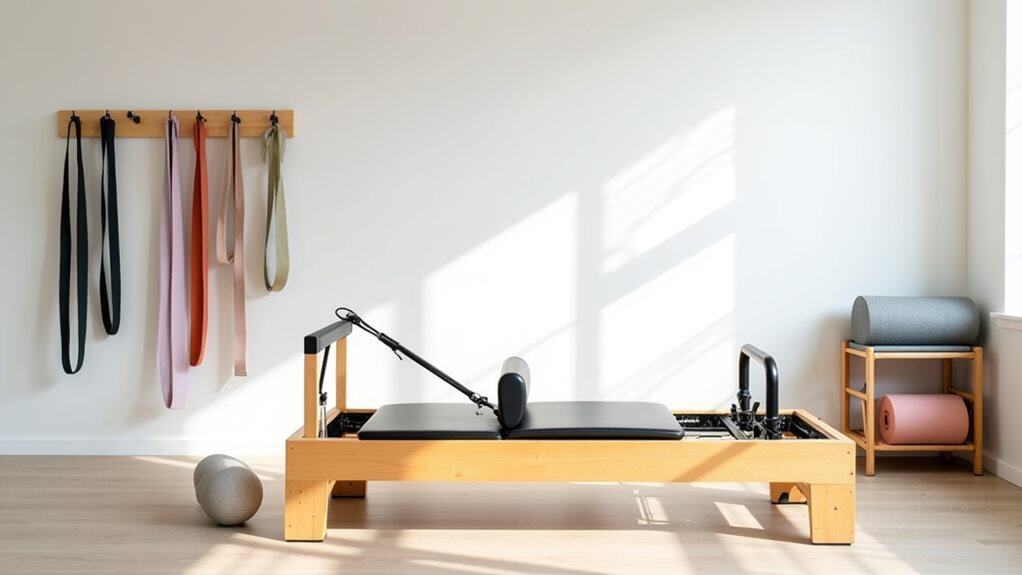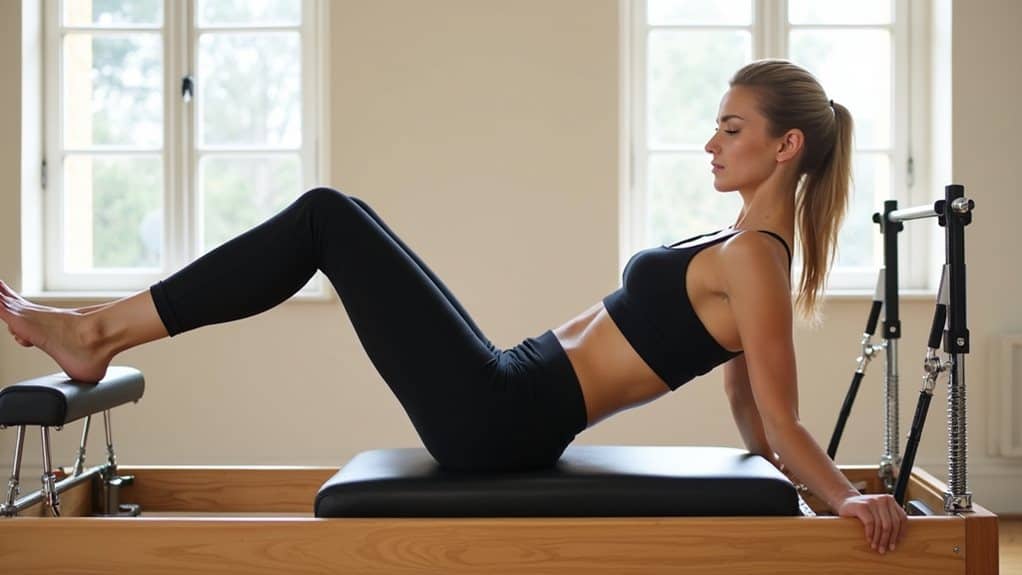Are you tired of feeling disconnected from your body? Do you want to unlock your full potential and live a life of freedom and vitality? Look no further than Pilates, the mind-body exercise practice that will transform the way you move, think, and feel.
With its focus on core strength, flexibility, and breath control, Pilates is more than just a workout – it’s a holistic approach to wellness that will enhance every aspect of your life.
Whether you’re an athlete looking to improve performance or simply seeking stress relief and relaxation, Pilates can help you unleash your true potential.
So why wait? Join the millions of people around the world who have discovered the transformative power of Pilates today.
Understanding the Principles of Pilates
Let’s dive into the core principles of Pilates so we can better understand how this unique workout can transform our bodies and minds.
The first step in mastering the technique is understanding the basics. Pilates principles include concentration, control, centering, precision, breath, and flow.
Concentration helps you focus on each movement while control ensures that your movements are precise and intentional.
Centering involves engaging your core muscles to support your spine and maintain balance.
Precision means performing every exercise with proper form to maximize its benefits.
Incorporating mindfulness into your Pilates practice is essential for experiencing the full mind-body connection.
Mindful movement involves being fully present in every moment of your workout, paying attention to how your body feels as you move through each exercise.
It also means listening to your body’s needs and adjusting accordingly, rather than pushing yourself beyond your limits or ignoring pain signals.
By mastering the Pilates principles and incorporating mindfulness into our practice, we can develop a deeper awareness of our bodies and minds.
This will help us unleash our full potential both on and off the mat.
Developing Mind-Body Awareness through Pilates
By developing an awareness of your breath and movement in Pilates, you may find a deeper sense of presence and connection within yourself. Mindful movement is at the core of Pilates, as it emphasizes the importance of being fully present in each exercise.
This means paying attention to how your body moves, where you feel tension or discomfort, and how you can adjust your movements to create more ease and fluidity. Through this process of body awareness, you can begin to understand the mind-body connection that is so integral to Pilates.
By focusing on your breath and movement patterns, you can tap into a deeper level of consciousness that allows for greater physical control and mental clarity. As you continue to practice Pilates with this mindful approach, you will likely notice improvements in both your physical abilities and overall well-being.
With this foundation in place, let’s explore how building core strength and flexibility can further enhance your Pilates practice.
Building Core Strength and Flexibility
Improving your physical abilities and overall well-being can be achieved by developing core strength and flexibility in Pilates. Core stability is essential for balance, posture, and preventing injury.
Pilates exercises focus on engaging the deep muscles of the abdomen, back, and pelvis to create a stable center from which movement can flow. Flexibility training in Pilates helps to increase range of motion in joints and elongate muscles. This leads to improved mobility, reduced muscle tension, and a greater sense of ease in everyday movements.
As you develop your core strength and flexibility through consistent practice of Pilates, you will notice increased control and fluidity in your movements both inside and outside the studio. By enhancing your mind-body connection through Pilates, you can unlock your full potential not just physically but mentally as well.
The next section will explore how this translates into enhancing athletic performance without sacrificing health or longevity.
Enhancing Athletic Performance
Get ready to take your physical abilities to the next level with Pilates’ secrets for enhancing athletic performance. Whether you’re a professional athlete or simply enjoy engaging in regular physical activity, Pilates can help improve your mental focus and prevent injury.
By focusing on proper alignment, controlled movements, and breath work, Pilates helps athletes develop greater body awareness and control. In addition to improving physical performance, Pilates also offers mental benefits that can enhance athletic ability.
The mind-body connection that’s emphasized in Pilates helps athletes stay present and focused during their training sessions and competitions. This can lead to improved concentration and better decision-making skills on the field or court. Furthermore, the emphasis on injury prevention through proper technique and alignment can help athletes avoid common injuries that may hinder their progress.
So why not give Pilates a try to unlock your full potential? As you continue your journey towards unlocking your full potential with Pilates, it’s important to note that it also offers stress-reducing benefits that can improve overall well-being. Let’s explore how incorporating this practice into your routine can help reduce stress and anxiety levels.
Reducing Stress and Anxiety
Are you feeling overwhelmed and stressed out? The mind-body connection plays a crucial role in how we experience stress and anxiety.
Pilates offers a unique approach to stress management by incorporating physical movement, breathing techniques, and mindfulness practices. By cultivating inner calm and serenity through regular Pilates practice, you can reduce your stress levels and improve your overall well-being.
The Mind-Body Connection and Stress
You can achieve a sense of calm and control by focusing on your breathing and movements during Pilates, which can help alleviate stress. Mindfulness techniques are incorporated in Pilates to encourage you to be present in the moment and concentrate on your breath.
Relaxation methods such as deep breathing exercises also help decrease tension and anxiety levels. In addition, practicing Pilates can increase the production of endorphins, which are natural mood boosters that reduce stress and pain levels.
This release of endorphins allows for a positive mindset, helping you to better cope with daily stressors. Moreover, practicing Pilates promotes physical strength and flexibility, which can improve confidence levels and provide an outlet for emotional expression.
By combining mindfulness techniques, relaxation methods, and physical movements, Pilates provides an all-encompassing approach to reducing stress levels. With these benefits in mind, it’s no wonder why many individuals turn to Pilates for stress management purposes.
Pilates for Stress Management
By incorporating mindfulness techniques and relaxation methods into its physical movements, Pilates can create a sanctuary of serenity for both the mind and body.
Pilates and mindfulness go hand in hand, as the practice emphasizes the importance of being present in the moment and focusing on each movement. By doing so, you’re able to quiet your mind and release any tension or stress that may be weighing you down.
Pilates for relaxation involves controlled breathing, slow and deliberate movements, and an emphasis on proper alignment. As you move through each pose with intention and focus, you become more aware of your body’s sensations and can identify areas of tightness or discomfort.
This heightened awareness allows you to release tension where needed, resulting in a sense of calm throughout your entire being. With regular practice, Pilates can become a powerful tool for managing stress and cultivating inner calm and serenity.
Cultivating Inner Calm and Serenity
Discover how Pilates can help you tap into a deeper sense of peace and tranquility within yourself. Mindful breathing is a key component to cultivating inner calm and serenity during your Pilates practice. By focusing on your breath, you can bring awareness to the present moment and quiet the mind from distracting thoughts.
This allows for greater relaxation in the body, leading to a more fulfilling Pilates experience. Relaxation techniques are also important in fostering a serene state of being. Incorporating gentle stretches and movements with intention and purpose can relax tense muscles and promote overall relaxation in the body.
Additionally, taking time to reflect on your intentions for your practice can give you greater clarity of mind, allowing you to fully embrace the benefits of Pilates for inner calm and serenity. As you continue your journey towards unlocking your full potential through Pilates, consider customizing your practice to fit your specific needs and goals.
Customizing Your Pilates Practice
Tailor your Pilates routine to fit your needs and goals, making it a personalized experience that’s as unique as you are. Personalizing routines is an important aspect of Pilates, allowing you to modify exercises based on your body’s capabilities and limitations. This ensures that you get the most out of each session while minimizing the risk of injury.
Modifying exercises also allows you to focus on specific areas that need improvement or attention. Whether it’s strengthening your core, improving flexibility, or increasing overall body awareness, customizing your Pilates practice can help you achieve these goals more effectively. Don’t be afraid to experiment with different routines and modifications until you find what works best for you.
By doing so, you’ll not only improve your physical health but also cultivate a deeper mind-body connection that can benefit every aspect of your life. Ready to take things a step further? Let’s explore how incorporating Pilates into your daily life can help you unlock even more potential!
Incorporating Pilates into Your Daily Life
Now that you’ve customized your Pilates practice, it’s time to incorporate it into your daily life. Luckily, there are many ways to do this!
You can practice Pilates at home with online classes or DVDs, sneak in some exercises during breaks at work, or even take your mat with you on the go for a quick session wherever you may be.
By finding ways to fit Pilates into your daily routine, you’ll be able to reap all of its amazing benefits and continue strengthening both your mind and body.
Pilates at Home
Get the most out of your Pilates practice by incorporating it into your daily routine at home. At-home Pilates workouts are a great way to stay consistent with your practice without having to worry about commuting and scheduling classes. Plus, you can save money on class fees and equipment rentals by investing in Pilates equipment for home use.
To make the most of your at-home practice, here are three things you can do:
-
Create a dedicated space: Designate an area in your home that will be used exclusively for your Pilates practice. This will help put you in the right mindset and make it easier to stay focused.
-
Set goals: Write down specific goals that you want to achieve through your Pilates practice. Keep these goals visible so that you can stay motivated.
-
Mix it up: Don’t get stuck doing the same routine every day. Switch up your exercises and try different sequences to challenge yourself and keep things interesting.
With these tips, you’ll be able to enjoy all the benefits of Pilates from the comfort of your own home.
And if you’re interested in taking it even further, read on for how you can incorporate Pilates into your workplace routine.
Pilates in the Workplace
Oh, so you think sitting in your uncomfortable office chair for eight hours a day is the way to go? Let me tell you about Pilates in the Workplace and how it can save your poor posture and achy muscles.
Incorporating Pilates exercises into your workday routine has numerous workplace benefits that can improve both your physical and mental health. Corporate wellness programs are becoming more common, and adding Pilates sessions to the mix can make a significant difference in employee productivity, morale, and overall well-being.
Pilates exercises designed specifically for the workplace focus on stretching tight muscles, strengthening weak ones, improving posture and balance, increasing flexibility, and reducing stress levels. These exercises can be done right at your desk or in a designated area with a certified instructor during lunch breaks or after-work hours.
By incorporating Pilates into your daily routine at work, you’ll feel more energized throughout the day and experience less discomfort from sitting for extended periods. Remember that taking care of yourself physically will positively impact other areas of your life too!
Transitioning into the subsequent section about ‘pilates on the go,’ have you ever felt like you didn’t have enough time outside of work to fit in some exercise? Don’t worry; we’ve got you covered with Pilates on-the-go!
Pilates on the Go
Incorporating Pilates into your busy schedule just got easier with Portable Pilates. Whether you’re traveling for work or pleasure, there’s no need to miss out on your favorite workouts.
With portable equipment and Pilates travel tips, you can take your practice with you wherever you go. The key to a successful Pilates practice on-the-go is preparation. Pack lightweight equipment such as resistance bands or a mini stability ball in your luggage, and research local studios or outdoor spaces where you can continue your routine.
By staying committed to your practice even while traveling, you’re prioritizing self-care and setting yourself up for success in all areas of life. Now, let’s explore how living your best life with Pilates goes beyond just physical fitness.
Living Your Best Life with Pilates
Living your best life is all about finding balance and harmony, just like a well-oiled machine humming smoothly. And one way to achieve that balance is through Pilates.
Pilates for well-being focuses on the mind-body connection, allowing you to tap into your full potential and experience a more fulfilling life. Pilates for personal growth not only strengthens your body but also enhances mental clarity and emotional stability.
As you practice Pilates regularly, you’ll notice improved posture, flexibility, and core strength. But more than that, you’ll learn to be present in the moment, let go of stress and tension, and cultivate a positive mindset.
By taking care of yourself through Pilates, you’re investing in your overall well-being and unlocking new levels of freedom in all areas of your life.
Frequently Asked Questions
What is the history of Pilates and how has it evolved over time?
You might be surprised to know that Pilates has been around for over a century. It was created by Joseph Pilates, who originally called it ‘Contrology,’ in the early 1900s. He developed the practice while working with injured soldiers during World War I and later opened his own studio in New York City where he trained other instructors.
Over time, Pilates has evolved into a popular form of exercise that focuses on strengthening the core, improving flexibility, and promoting overall well-being. Today, there are many influential teachers and practitioners who have helped shape the way we think about this powerful mind-body practice.
From its origins as a rehabilitation method to its current status as a mainstream fitness trend, Pilates continues to inspire people all over the world to unlock their full potential both physically and mentally.
Can Pilates be used as a form of rehabilitation for injuries or chronic pain?
Did you know that Pilates can be an effective form of rehabilitation for injuries or chronic pain? According to a study published in the Journal of Orthopedic and Sports Physical Therapy, Pilates improves strength, flexibility, and balance, while also teaching pain management techniques.
By focusing on proper alignment and engaging specific muscle groups, Pilates helps alleviate pressure on joints and reduce discomfort. Additionally, the mind-body connection inherent in Pilates encourages a deeper understanding of how your body works, allowing you to better manage and prevent future injury.
Whether you’re recovering from an injury or dealing with chronic pain, incorporating Pilates into your rehabilitation plan can have numerous benefits for both your physical health and mental well-being.
How does Pilates compare to other forms of exercise, such as yoga or weightlifting?
If you’re looking for a low-impact exercise that can provide numerous benefits, Pilates might be the perfect choice.
While yoga and weightlifting have their own unique advantages, Pilates offers a combination of strength training, flexibility, and balance work that can improve your overall fitness level.
Plus, because it’s a low-impact exercise, Pilates is ideal for people who want to avoid putting stress on their joints.
When it comes to effectiveness comparison, Pilates has been shown to be just as effective as other forms of exercise when it comes to building muscle strength and endurance.
Additionally, Pilates can help improve posture and reduce risk of injury thanks to its focus on proper alignment and controlled movements.
Overall, if you’re looking for an engaging workout that will help you unleash your full potential without sacrificing safety or joint health, Pilates is definitely worth checking out!
Are there any precautions or contraindications for practicing Pilates, particularly for individuals with certain medical conditions?
Before starting any form of exercise, it’s important to consider precautionary measures that may need to be taken for certain medical conditions.
Pilates is a low-impact form of exercise that can be beneficial for many individuals, but there are some who may need to take extra care when practicing.
For example, those with back injuries or chronic pain should consult with their doctor before beginning a Pilates program and should work closely with a qualified instructor who can modify exercises as needed.
Additionally, pregnant women should seek guidance from their healthcare provider before participating in Pilates classes.
By taking these precautions and being mindful of any medical conditions, individuals can safely experience the benefits of Pilates while minimizing the risk of injury or discomfort.
How can Pilates be combined with other wellness practices, such as meditation or nutrition, to enhance overall health and wellbeing?
If you’re looking to enhance your overall health and wellbeing, consider combining Pilates with other wellness practices like meditation or nutrition.
The synergy between Pilates and meditation can be particularly powerful, as both focus on the mind-body connection. By incorporating mindfulness into your Pilates practice, you can deepen your awareness of your body’s movements and sensations, leading to greater physical and mental benefits.
Similarly, pairing Pilates with a balanced and nutritious diet can help fuel your workouts and support recovery.
Overall, by integrating these complementary practices into your routine, you can unlock even more potential for growth and self-improvement.
Conclusion
Congratulations! You’ve learned about the amazing benefits of Pilates and how it can help you unleash your full potential.
Through understanding the principles of Pilates, developing mind-body awareness, building core strength and flexibility, enhancing athletic performance, reducing stress and anxiety, customizing your practice, and incorporating Pilates into your daily life, you can experience a transformation in both body and mind.
As the saying goes, “Rome wasn’t built in a day.” It takes time and effort to see results from any fitness regimen. However, with consistent practice and dedication to Pilates, you’ll begin to notice improvements in posture, balance, coordination, strength, and flexibility while also feeling more relaxed mentally.
Don’t let fear or doubt hold you back from trying something new. Take that first step towards living your best life with Pilates today. Remember: every journey begins with a single step!




